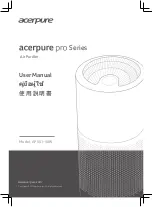
145
Causes and corrective actions
(2) Warning
When the protective circuit is activated, the output is not shut off.
Operation Panel
Indication
Err.
Description
y
The RES signal is ON
y
The PU and inverter cannot make normal communication (contact fault of the connector)
y
When the voltage drops in the inverter's input side.
y
When the control circuit power (R1/L11, S1/L21) and the main circuit power (R/L1, S/L2, T/L3) are
connected to a separate power, it may appear at turning ON of the main circuit. It is not a fault.
Corrective action
y
Turn OFF the RES signal.
y
Check the connection of the PU and inverter.
y
Check the voltage on the inverter's input side.
Operation Panel
Indication
OL
FR-PU04
FR-PU07
OL
Name
Stall prevention (overcurrent)
Description
During
acceleration
When the output current (output torque during Real sensorless vector control or vector
control) of the inverter exceeds the stall prevention operation level (
Pr. 22 Stall prevention
operation level
, etc.), this function stops the increase in frequency until the overload
current decreases to prevent the inverter from resulting in overcurrent trip. When the
overload current has decreased below stall prevention operation level, this function
increases the frequency again.
During
constant
speed
operation
When the output current (output torque during Real sensorless vector control or vector
control) of the inverter exceeds the stall prevention operation level (
Pr. 22 Stall prevention
operation level
, etc.), this function reduces frequency until the overload current
decreases to prevent the inverter from resulting in overcurrent trip. When the overload
current has decreased below stall prevention operation level, this function increases the
frequency up to the set value.
During
deceleration
When the output current (output torque during Real sensorless vector control or vector
control) of the inverter exceeds the stall prevention operation level (
Pr. 22 Stall prevention
operation level
, etc.), this function stops the decrease in frequency until the overload
current decreases to prevent the inverter from resulting in overcurrent trip. When the
overload current has decreased below stall prevention operation level, this function
decreases the frequency again.
Check point
y
Check that the
Pr. 0 Torque boost
setting is not too large.
y
Check that the
Pr. 7 Acceleration time
and
Pr. 8 Deceleration time
settings are not too small.
y
Check that the load is not too heavy.
y
Are there any failure in peripheral devices?
y
Check that the
Pr. 13 Starting frequency
is not too large.
·
Check the motor for use under overload.
y
Check that the
Pr. 22 Stall prevention operation level
is appropriate.
Corrective action
y
Increase or decrease the
Pr. 0 Torque boost
value 1% by 1% and check the motor status.
(Refer to page 59.)
y
Set a larger value in
Pr. 7 Acceleration time
and
Pr. 8 Deceleration time
.
(Refer to page 61.)
y
Reduce the load weight.
y
Try Advanced magnetic flux vector control, Real sensorless vector control or vector control.
y
Change the
Pr. 14 Load pattern selection
setting.
y
Set stall prevention operation current in
Pr. 22 Stall prevention operation level
. (The initial value is
150%.) The acceleration/deceleration time may change. Increase the stall prevention operation level
with
Pr. 22 Stall prevention operation level
, or disable stall prevention with
Pr. 156 Stall prevention
operation selection
. (Use
Pr. 156
to set either operation continued or not at OL operation.)
Operation Panel
Indication
oL
FR-PU04
FR-PU07
oL
Name
Stall prevention (overvoltage)
Description
During
deceleration
y
If the regenerative energy of the motor becomes excessive and exceeds the
regenerative energy consumption capability, this function stops the decrease in
frequency to prevent overvoltage trip. As soon as the regenerative energy has
decreased, deceleration resumes.
y
If the regenerative energy of the motor becomes excessive when regeneration
avoidance function is selected (
Pr. 882
= 1), this function increases the speed to
prevent overvoltage trip.
(Refer to Chapter 4 of
the Instruction Manual (Applied).)
Check point
y
Check for sudden speed reduction.
y
Regeneration avoidance function
(Pr. 882 to Pr. 886)
is being used?
(Refer to Chapter 4 of
the
Instruction Manual (Applied).)
Corrective action
The deceleration time may change.
Increase the deceleration time using
Pr. 8 Deceleration time
.
















































